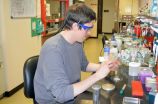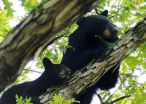INFORMATION:
Pengbo Cao, a UW doctoral student in Molecular and Cellular Life Sciences (MCLS), and Darshankumar Pathak, a then-UW doctoral student (since graduated) in MCLS, were other UW researchers who contributed. David Zuckerman and Egbert Hoiczyk from the W. Harry Feinstone Department of Molecular Biology and Immunology at Johns Hopkins Bloomberg School of Public Health also contributed to the paper.
Bacteria cooperate to repair damaged siblings
2015-05-21
(Press-News.org) May 21, 2015 - A University of Wyoming faculty member led a research team that discovered a certain type of soil bacteria can use their social behavior of outer membrane exchange (OME) to repair damaged cells and improve the fitness of the bacteria population as a whole.
Daniel Wall, a UW associate professor in the Department of Molecular Biology, and others were able to show that damaged sustained by the outer membrane (OM) of a myxobacteria cell population was repaired by a healthy population using the process of OME. The research revealed that these social organisms benefit from group behavior that endows favorable fitness consequences among kin cells.
Wall says, to the research group's knowledge, this is the first evidence that a bacterium can use cell-content sharing to repair damaged siblings.
"It is analogous to how a wound in your body can be healed," Wall says. "When your body is wounded, your cells can coordinate their functions to heal the damaged tissue."
Wall was the senior and corresponding author on a paper, titled "Cell Rejuvenation and Social Behaviors Promoted by LPS Exchange in Myxobacteria" that was published in the May 18 online issue of the Proceedings of the National Academy of Sciences (PNAS). The journal is one of the world's most prestigious multidisciplinary scientific serials, with coverage spanning the biological, physical and social sciences.
Chris Vassallo, a UW doctoral student in molecular biology and originally from Cheyenne, was the paper's lead author and conducted most of the lab experiments.
"During nutrient depletion, myxobacteria cooperate to build a macroscopic structure called a fruiting body," Vassallo says. "The structure resembles a tree or mushroom in appearance."
A fruiting body is essentially a multicellular organism that produces dormant spores that are resistant to environmental stresses.
These myxobacterial cells, in their native environments, must cope with factors that compromise the integrity of the cell, Wall says. Rather than looking out only for themselves like other bacterial species, the individual myxobacteria cells band together as a social group to assist their kin that become damaged.
"Myxobacteria are unusual for bacteria in that they have a true multicellular life," Wall says. "Researchers are interested in how the evolutionary transition occurred toward multi-cellularity; that is, how cooperation develops and single cells are not just interested in themselves. The Darwinian view is that each individual is out for themselves; 'survival of the fittest.'"
"When environmental cells come together, they compete with each other," Wall continues. "With OME, we think it allows myxobacteria cells to transition from a heterogeneous single cellular life to a more harmonious multicellular life."
While the practical application of the science is to better understand how single cells can evolve to multicellular cells to be cooperative, Vassallo says the research could possibly have future real-world implications for treating infections in humans.
"The most direct applicability could be for antibiotic resistance," Wall says. "Within the paper, Chris did an experiment where one strain of myxobacteria conferred antibiotic resistance to another strain. This works by the cells transferring their OM armor.
"The human skin protects the body and internal cells from environmental stresses. By analogy, bacteria protect themselves with their OM, and they are known to change their armor in response to stress. When they chemically change their armor, they can also change their antibiotic resistance profile."
ELSE PRESS RELEASES FROM THIS DATE:
CloudSat analyzed the eye of Typhoon Dolphin
2015-05-21
When Dolphin was a typhoon on May 16, NASA's CloudSat satellite completed a stunning eye overpass of Typhoon Dolphin in the West Pacific at 0412 UTC (12:12 a.m. EDT). By May 22, Dolphin's remnants were moving through the Northern Pacific.
NASA's CloudSat satellite sends pulses of microwave energy through the clouds, and some of the energy in the pulses is reflected back to the spacecraft. The time delay between when the pulse is sent and when the reflected energy is received back at the spacecraft is mapped into a distance of the cloud from the surface of the Earth, and ...
Genetic maps help conservation managers maintain healthy bears
2015-05-21
COLUMBIA, Mo. - Last year, researchers at the University of Missouri published a study on genetic diversity in American black bears in Missouri, Arkansas and Oklahoma and determined that conservation management is needed to maintain healthy populations in the region. Now, those scientists have expanded the study to include black bears throughout North America. They discovered that black bears in Alaska are more closely related to bears in the eastern regions of the U.S. and Canada than those located in western regions. Details from the study revealed ancient movement patterns ...
Low stent thrombosis rates with primary PCI, regardless of antithrombotic choice
2015-05-21
(PARIS, FRANCE) - Stent thrombosis following urgent angioplasty for acute heart attack occurred in less than 1% of patients in a large, "real-world" registry, regardless of whether the antithrombotic treatment used during the procedure was bivalirudin, heparin alone, or a GP IIb/IIIa inhibitor (typically in combination with heparin).*
However, patients who experienced a stent thrombosis between days 2 and 30, regardless of drug regimen, were more likely to die within one year than were patients who developed stent thrombosis within the first 24 hours of their procedure.
"What ...
Pliability, elasticity of skin increase following wrinkle treatment with Botox
2015-05-21
Skin pliability and elasticity improved after treatment with onabotulinum toxin (Botox) for mild facial wrinkles and the effect lasted for up to four months, according to a report published online by JAMA Facial Plastic Surgery.
Human skin has three biomechanical features: strength, pliability (the ability to stretch) and elasticity (the ability to recoil). As people age, these properties change and the loss of skin elasticity appears to be the most prominent. Physicians use a variety of methods to reverse the signs of aging and onabotulinum toxin A injections are among ...
Personalized care during eye visits didn't lower HbA1c levels for diabetics
2015-05-21
Providing personalized education and risk assessment for patients with diabetes when they visit the ophthalmologist did not improve glycemic control as measured by hemoglobin A1c levels compared with patients who received usual care, according to a study published online by JAMA Ophthalmology.
Intensive blood glucose control can reduce the onset and progression of microvascular complications in people with diabetes. However, optimal glycemic control as measured by HbA1c is notoriously difficult to achieve. A potential strategy to improve glycemic control is to leverage ...
Workplace intervention improves sleep of employees' children
2015-05-21
A workplace intervention designed to reduce employees' work-family conflict and increase schedule flexibility also has a positive influence on the sleep patterns of the employees' children.
The intervention, Support-Transform-Achieve-Results (STAR), includes training supervisors to be more supportive of their employees' personal and family lives, changing the structure of work so that employees have more control over their work time, and changing the culture in the workplace so that colleagues are more supportive of each other's efforts to integrate their work and personal ...
Odds are that chronic gamblers are often also depressed
2015-05-21
If a young man is a chronic gambler, the chances are extremely high that he also suffers from depression. This is one of the findings from a study led by Frédéric Dussault of the University of Quebec at Montreal in Canada. Published in Springer's Journal of Gambling Studies, it is the first to investigate the extent to which gambling and depression develop hand-in-hand from the teenage years to early adulthood.
Data were drawn from an ongoing long-term study that began in 1984. It follows a group of 1,162 kindergarten boys from economically disadvantaged areas ...
Fine particulate air pollution associated with increased risk of childhood autism
2015-05-21
PITTSBURGH, May 21, 2015 -- Exposure to fine particulate air pollution during pregnancy through the first two years of a child's life may be associated with an increased risk of the child developing autism spectrum disorder (ASD), a condition that affects one in 68 children, according to a University of Pittsburgh Graduate School of Public Health investigation of children in southwestern Pennsylvania.
The research is funded by The Heinz Endowments and published in the July edition of Environmental Research.
"Autism spectrum disorders are lifelong conditions for which ...
Emoticons may signal better customer service ;)
2015-05-21
Online customer service agents who use emoticons and who are fast typists may have a better chance of putting smiles on their customers' faces during business-related text chats, according to researchers.
In a study, people who text chatted with customer service agents gave higher scores to the agents who used emoticons in their responses than agents who did not use emoticons, said S. Shyam Sundar, Distinguished Professor of Communications and co-director of the Media Effects Research Laboratory. The customers also reported that agents who used emoticons were more personal ...
CWRU dental researchers find some immune cells change to prolong inflammation
2015-05-21
Researchers at Case Western Reserve University School of Dental Medicine have unraveled one of the mysteries of how a small group of immune cells work: That some inflammation-fighting immune cells may actually convert into cells that trigger disease.
Their findings, recently reported in the journal Pathogens, could lead to advances in fighting diseases, said the project's lead researcher Pushpa Pandiyan, an assistant professor at the dental school.
The cells at work
A type of white blood cell, called T-cells, is one of the body's critical disease fighters. Regulatory ...


